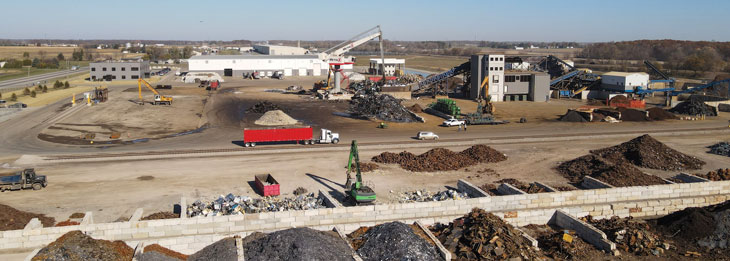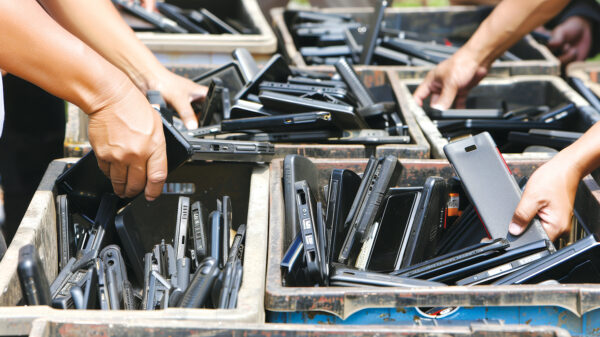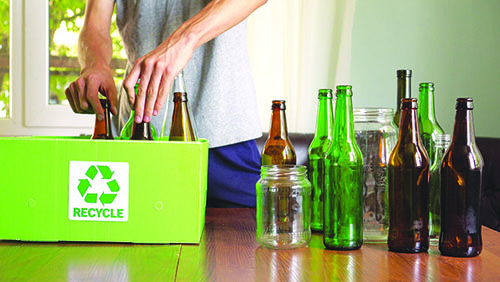Technological advancements within the recycling sector have taken the metal recycling industry by storm, enhancing collection, identification, sorting and other key processes.
Derek Pritchett is the senior vice president of corporate development at Novelis, a global leader in the production of innovative aluminum products and solutions and the world’s largest recycler of aluminum. According to Pritchett, improving high-speed sortation of municipal and industrial scrap has been the area of greatest opportunity for technological advancement within the recycling industry.
“Traditional processes deployed in material recovery facilities (MRFs) are highly effective for separating aluminum, steel and other metals from a mixed-material stream, but are less effective for sorting plastics and paper by type and are completely ineffective for segregating alloys in industrial scrap,” Pritchett said. Recently developed technology uses vision systems and infrared to improve both the speed and accuracy of sorting. Some of the systems also integrate AI to assist with scrap analysis and reporting.
As Pritchett explained, in an industrial setting, technology enables companies to recycle automotive scrap and segregate aluminum alloys to preserve their value. When scrap comes into a facility, it often includes different types of alloys that need to be sorted in order to create product.
“For example, in automotive scrap, we have to separate the 5,000-series alloys from the 6,000-series alloys before we can recycle it and produce new automotive sheets. Technology to accomplish this has been in development for about 10 years,” Pritchett said. “The systems sort alloys accurately but not at high rate, so that is an area where we expect to see improvement in the years ahead.” Some systems use lasers while others – including the Sortera system that Novelis has invested in – use an x-ray method that operates at a slightly higher speed.
Alastair McFarlane, sustainability expert at PA Consulting, said leading MRFs are integrating more advanced and diversified equipment, and making informed decisions through increased use of data analytics and machine learning.
“They are combining higher resolution sensors and cameras with more advanced sorting equipment, with accompanying software to enable process optimization and automation,” McFarlane said. “The result is high throughput and high accuracy identification and sorting of metal scrap.”
It goes without saying that the technological advancements facing the recycling industry are making significant advancements in industry processes and procedures. As Pritchett pointed out, improved separation and material segregation technologies help preserve the value of the materials in the scrap stream, which is a key recycling objective.
“Each time material is recycled, we want it to be used to its highest value rather than downcycling it for a lower-value application,” Pritchett said. “The more efficient the sorting the higher the quality of the recycled materials – which can help increase demand and drive growth in the industry.”
Offsetting Contamination Issues
Some of today’s well-intentioned consumers negate the impact of their recycling efforts, especially when attention is paid to the contamination issue facing mixed-use recycling. But luckily, technology advancements are helping with this issue.
As Pritchett explained, contamination is a real issue in single-stream recycling. For example, when recycling beverage cans, there is always some paper and plastic mixed in with the aluminum. Small amounts can be eliminated during the recycling process, but at a certain point it becomes a problem. Technology can help minimize contamination and keep it within tolerable ranges.
“That’s important because the goal of recycling is not simply to reuse the material from the scrap stream; we want to maximize its value by returning to its highest possible use. If we are recycling cans, for example, we want to recover that material in a way that allows us to recycle it into new cans,” Pritchett said. “That requires highly reliable and efficient sortation, which new technologies are enabling.”
One challenge facing the industry in this regard, however, is that there is not strong demand for all materials, which Pritchett said makes it difficult to justify the cost of recovery and recycling.
“The demand for recycled aluminum is always higher than supply, and copper is also a high value scrap material. In contrast, glass is very low-value and often used in downgraded products such as aggregate for building roads,” Pritchett said. “Similarly, certain grades of plastic are not easily recycled into new containers and are of low value in the system. They require energy-intensive processes to recycle into feed stock, and they degrade with each recycling, which can be a concern for plastics used in consumer products.”
McFarlane added that tackling contamination is a shared issue throughout the full value chain, and the most cost-effective interventions are arguably found upstream. “Nonetheless, combining multiple steps of metal separation, such as current separation optimized for different fractions of nonferrous scrap, with high-resolution color detection, can enable recovery of multiple fractions from even highly contaminated waste streams,” McFarlane said.
Ultimately, there is a limit to purity levels that can be feasibly achieved. “Recognizing this reality, an exciting area of research is the development of machine learning tools that can assess the optimal secondary uses of materials based on contamination levels and profiles,” McFarlane said. “This offers the potential to preserve the economic value of recyclates.”
The Waste-To-Energy Component
One key technological advancement within the recycling and waste handling industry is the waste-to-recycling component. As Ole Hedegaard Madsen, senior director of technology and business development at Babcock & Wilcox, explained, the team at Babcock & Wilcox view generating energy from waste as a vital part of a strong and sustainable waste management chain.
“It is fully complementary to recycling and is an economically and ecologically sound way to produce renewable energy while diverting waste from landfills,” Hedegaard Madsen said.
Babcock & Wilcox’s waste-to-energy technologies have been developed and refined over many decades and include boilers, state-of-the-art combustion grates and emissions control systems to help customers use municipal and industrial waste that remains after metals, certain plastics, and other recyclables are removed from the waste stream to generate power and steam for heating and industrial uses.
“Producing clean, reliable base-load energy from waste isn’t just a trash disposal method to avoid harmful landfills,” Hedegaard Madsen said. “It’s also a way to recover valuable resources and enhance recycling efforts. Today, it is possible to reuse 90% of the metals contained in the bottom ash left over after burning waste, and the remaining ash can be re-used in road construction and other industrial processes.”
As Hedegaard Madsen further explained, communities that use waste to produce energy also generally have higher overall recycling rates than those that don’t, while diverting waste from landfills also helps avoid methane emissions and offsets greenhouse gas emissions from fossil fuel electrical production. WTE also requires less land per megawatt than most other renewable energy sources.
“A great example of the impact a WTE facility can have is seen in the Amager Bakke facility in Copenhagen, Denmark. This facility integrates B&W’s WTE technology to form a practical solution to meet clean energy demands, treating approximately 400,000 tons of waste each year and generating electricity to power 50,000 households, as well as provide district heating for 120,000 households,” Hedegaard Madsen said. “The facility actually has become a tourist attraction due to a roof-wide artificial ski slope, hiking trail and climbing wall, all of which are open to the public.”
Ongoing Advancements
As new sortation technologies become adopted more widely, Pritchett said it is likely that the recycling industry will see growth in the use of robotics as well. Many of these systems integrate AI and robotics, enabling them to perform the same physical tasks as humans but at a higher speed and with greater accuracy.
“Robotics are essential for segregating alloys in industrial scrap as humans aren’t capable of identifying alloys and sorting them by type,” Pritchett said. “I expect that we are at the front end of a long-term growth curve in the use of robotics and AI within the recycling industry.”
For MRFs, McFarlane said the investment case for use of robotics will increasingly stack up as equipment costs drop and more seamless integration of sensors and robotic sorting is achieved. “Adoption will be fastest where the economics are in place for highest throughput, sorting accuracy and purity levels at MRFs,” added McFarlane.
An area still developing that hasn’t matured yet is traceability. According to Pritchett, it is becoming increasingly important to track material all the way through the supply chain, from point of origin through recycling.
“It’s particularly important when certifying the recycled content of products, or documenting chain of custody, to ensure material isn’t coming from restricted sources and that it is of appropriate quality,” Pritchett said. “There is a great opportunity for growth in this area, but it is extremely complex because so many players are involved.”
by MAURA KELLER
mkeller@americanrecycler.com







